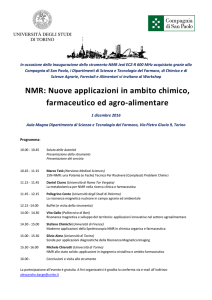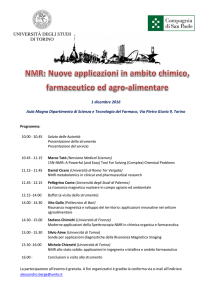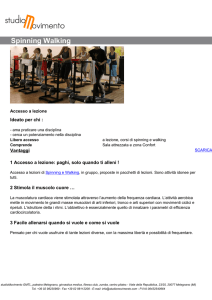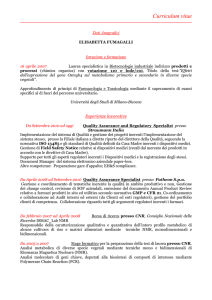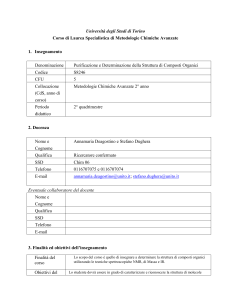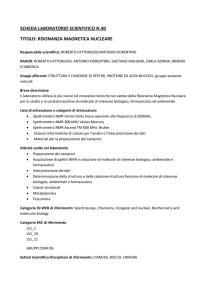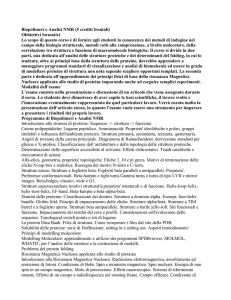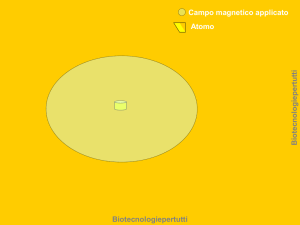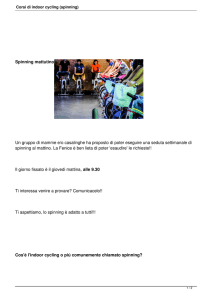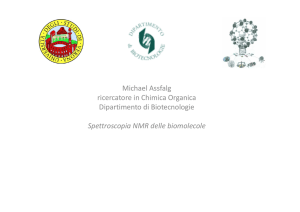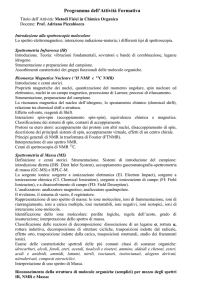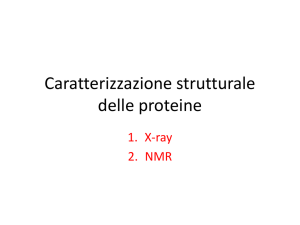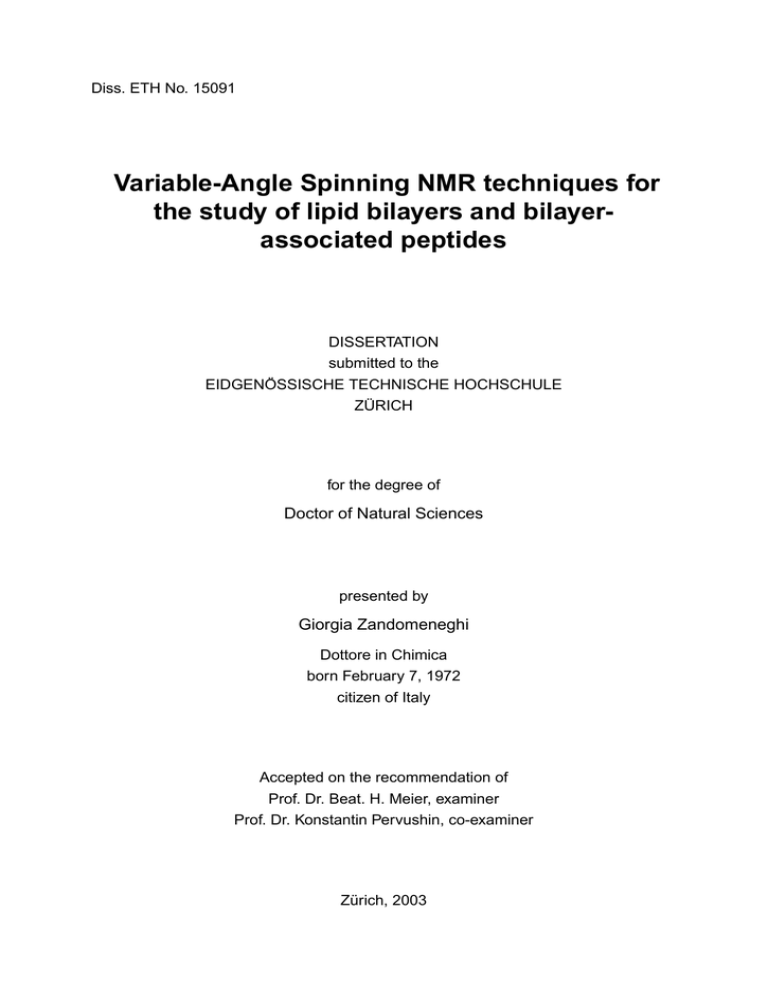
Diss. ETH No. 15091
Variable-Angle Spinning NMR techniques for
the study of lipid bilayers and bilayerassociated peptides
DISSERTATION
submitted to the
EIDGENÖSSISCHE TECHNISCHE HOCHSCHULE
ZÜRICH
for the degree of
Doctor of Natural Sciences
presented by
Giorgia Zandomeneghi
Dottore in Chimica
born February 7, 1972
citizen of Italy
Accepted on the recommendation of
Prof. Dr. Beat. H. Meier, examiner
Prof. Dr. Konstantin Pervushin, co-examiner
Zürich, 2003
11
Abstract
In this thesis novel NMR techniques for the study of phospholipid bilayers and
bilayer-bound peptides in magnetically oriented media (bicelles) are presented.
Bicelles are model membranes composed of a mixture of long- and short-chain
phospholipids in water. Bicelles can form nematic liquid-crystalline phases, which in
presence of a magnetic field, align with the liquid-crystalline director perpendicular to
the magnetic field. In this phase the phospholipids are assumed to form bilayered
disks with a planar bilayer of long-chain lipids surrounded by a rim of shorter-chain.
Bicelles offer distinct advantages over the commonly used multilamellar
liposomes as model of phospholipid membranes in the NMR study of membraneassociated proteins. Oriented phospholipid bilayers, like bicelles, often result in NMR
spectra characterized by higher resolution and signal-to-noise ratio than the spectra
obtained in multilamellar liposomes. In fact, if the molecular rotation within the bilayer
is rapid or the liquid-crystalline director is aligned with the magnetic field direction, the
resulting spectra are well resolved with a single resonance line per site. At the same
time, these spectra are rich with structural information because the resonance
frequency encodes the isotropic and anisotropic spin interactions.
In the first part of this thesis I will show that bicelles can be oriented with the
director at an arbitrary angle to the applied magnetic field, including the parallel
orientation, by sample rotation around one axis (variable-angle sample spinning) or
around two axes successively (switched-angle spinning). The possibility of controlling
the orientation of the bilayers and, therefore, to manipulate the contribution of the spin
anisotropic interactions, provides an additional experimental parameter and opens
novel possibilities for NMR studies of bicelles and proteins reconstituted into bicelles.
In particular, it can be used to disentangle the anisotropic and isotropic contributions
to the resonance position, as discussed below.
12
Abstract
The second part of the thesis presents some applications of sample-spinning
methods for the study of biomolecules reconstituted into bicelles. In particular, we
investigated two membrane peptides, which correspond to the different kind of
interactions between lipids and membrane proteins present in nature: an integral
protein (the transmembrane domain M4 of the γ subunit of the nicotinic acetylcholine
receptor) and a peripheral protein (the opioid peptide leucine enkephalin, Lenk). The
spectra of the transmembrane domain M4, labelled with NMR sensitive isotopes and
reconstituted into bicelles, are recorded under static and magic-angle spinning
conditions. The isotropic chemical shieldings and the chemical-shielding anisotropies
of the labelled residues can be measured and information about the dynamics and the
secondary structure of the M4 within the bilayer is provided. Furthermore, the
orientation of the peptide with respect to the lipid bilayer can be determined. Lenk is a
water-soluble pentapeptide which associates with the membrane surface. The
conformation
of
bicelle-associated
Lenk
has
been
studied
applying
NMR
multidimensional experiments to isotropic bicelle/Lenk systems. Isotropic bicelles are
small bicelles which tumble fast and isotropically and provide isotropic NMR signals.
The spectral resolution for a peptide associated to oriented bicelles under static
conditions is often limited due to a large number of anisotropic spin interactions. This
is particularly true for the proton spectra where the resonances are relatively broad,
mainly as a consequence of the strong proton-proton dipolar couplings. The spectral
resolution is greatly improved by magic-angle spinning. The high-resolution spectrum
under magic-angle spinning can be correlated with its anisotropic spectrum in twodimensional switched-angle spinning NMR spectra. The anisotropic spectrum is
obtained spinning the bicelle sample around an axis parallel to the magnetic field and
is identical to the static spectrum. The two-dimensional spectrum allows the
exploitation of the high resolution of the isotropic spectrum, while retaining the
structural information imparted by the anisotropic interactions in the static spectrum.
Furthermore, switched-angle spinning techniques are presented that allow one to
record the spectrum of ordered bicellar phases as a function of the angle between the
rotor axis and the magnetic field direction, thereby scaling the dipolar interactions by a
predefined factor. In a model study, the switched-angle spinning experiments
described above are applied to the proton NMR study of Lenk associated to oriented
bicelles.
13
Riassunto
In questa tesi sono presentate nuove tecniche per lo studio NMR di doppi-strati
fosfolipidici e dei peptidi legati ad essi, in sistemi uniassialmente orientati detti bicelle.
Le bicelle sono delle membrane-modello costituite da una miscela in acqua di due
fosfolipidi, che sono identici se non per la lunghezza della catena acilica. Le bicelle
possono formare fasi nematiche liquido-cristalline che, in presenza di un campo
magnetico, si orientano con il direttore disposto perpendicolarmente al campo
magnetico. Si ritiene che in questa fase i lipidi formino dei dischi costituiti da un piano
di doppio strato al centro (formato dal fosfolipide a catena lunga) e da un bordo
(formato dal fosfolipide a catena corta).
Le bicelle sono state introdotte per semplificare lo studio NMR delle proteine
associate alle membrane. Infatti, i liposomi multilamellari, che sono gli aggregati
lipidici generalmente usati come modello di membrana cellulare, originano spettri
NMR spesso caratterizzati da bassa risoluzione e da un modesto rapporto segnalerumore. I sistemi di lipidi macroscopicamente orientati con il direttore allineato con il
campo magnetico o con altra orientazione ma caratterizzati da una dinamica veloce
nel piano del doppio strato, producono invece spettri NMR ben risolti, con una sola
risonanza per sito molecolare. Allo stesso tempo, questi spettri sono ricchi di
informazione strutturale dal momento che la frequenza di risonanza dipende sia dalle
interazioni NMR isotrope che da quelle anisotrope.
Nella prima parte della tesi dimostro che le bicelle possono essere orientate con
il direttore inclinato di un angolo arbitrario rispetto al campo magnetico (e quindi
anche allineato con il campo), mediante la rotazione del campione attorno ad un asse
(“variable-angle sample spinning”) o attorno a due assi successivamente (“switchedangle spinning”). La possibilità di controllare l’ orientazione delle bicelle e, di
conseguenza, il contributo delle interazioni di spin anisotrope, fornisce un parametro
14
Riassunto
sperimentale in più e rende possibile la realizzazione di esperimenti innovativi per lo
studio NMR di bicelle e di proteine ricostituite in bicelle. In particolare, il controllo della
orientazione delle bicelle può essere utilizzato per separare il contributo delle
interazioni NMR isotrope alla frequenza di risonanza da quello delle interazioni
anisotrope.
La seconda parte della tesi presenta alcune applicazioni dei metodi
precedentemente proposti basati sulla rotazione di bicelle contenenti peptidi. In
particolare, vengono studiati due peptidi che esemplificano i diversi tipi di interazioni
peptide-membrana presenti in natura: un peptide transmembrana (il dominio
transmembrana M4 dalla subunità γ del recettore dell’ acetilcolina nicotinica) e un
peptide periferico (il peptide opioide leucine enkephalin, Lenk). Gli spettri del dominio
transmembrana M4 sintetizzato con isotopi attivi all’ NMR e ricostituito in bicelle sono
stati registrati in condizioni statiche e di rotazione all’ angolo magico (“magic-angle
spinning”). Il chemical shielding isotropo e l’ anisotropia di chemical-shielding dei
residui con isotopi NMR-attivi sono stati misurati, ottenendo così informazioni sui
processi dinamici e sulla struttura secondaria del dominio M4. E’ stato inoltre possibile
determinare l’ orientazione del peptide rispetto alla membrana. Il Lenk è un
pentapeptide solubile in acqua che si associa alla superficie della membrana. La
struttura del Lenk associato alla bicelle è stata studiata in un campione di bicelle
isotrope mediante esperimenti multidimensionali. Le bicelle isotrope sono bicelle di
dimensioni ridotte che si muovono velocemente e isotropicamente, dando così origine
a segnali NMR isotropi.
La risoluzione spettrale per un peptide associato a bicelle in un campione statico
può essere limitata per effetto delle interazioni NMR anisotrope. Questo è
particolarmente vero nel caso degli spettri al protone dove le risonanze sono piuttosto
larghe, soprattutto a causa di forti accoppiamenti dipolari protone-protone. La
risoluzione
spettrale
è
migliorata
considerevolmente
mediante
“magic-angle
spinning”. Lo spettro ad alta risoluzione del peptide associato alle bicelle in condizioni
di “magic-angle spinning” può essere correlato con lo spettro anisotropo
corrisponente in esperimenti bidimensionali basati sul cambiamento repentino della
orientazione dell’ asse di rotazione (“switched-angle spinning”). Lo spettro anisotropo
è ottenuto ruotando il campione attorno ad un asse parallelo al campo magnetico e
15
risulta essere identico allo spettro statico. Lo spettro bidimensionale basato sullo
“switched-angle spinning” permette lo sfruttamento dell’ alta risoluzione dello spettro
isotropo conservando allo stesso tempo l’ informazione strutturale dovuta alle
interazioni anisotrope presenti nello spettro statico. In aggiunta, si dimostra che le
tecniche di “switched-angle spinning” permettono di registrare spettri al protone di
sistemi di bicelle ben allineati in funzione dell’ angolo tra l’ asse di rotazione e la
direzione del campo magnetico, scalando in questo modo le interazioni di dipolo di un
fattore predefinito. In uno studio modello presentato nell’ ultima parte di questa tesi gli
esperimenti di “switched-angle spinning” sopra descritti sono applicati allo studio NMR
al protone del Lenk associato a bicelle.

